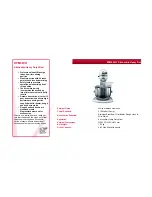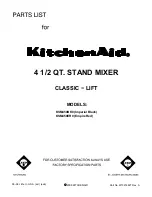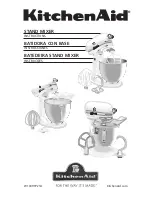
6
USER MANUAL
v2.1
JEFEHM-110
110V 1400W Electric Hand Mixer
www.jeffersontools.com
ELECTRICAL SAFETY
Ensure that you check the equipment thoroughly to ensure it is safe and fit for purpose before each
use. It is important that you inspect all plugs, sockets, power cables and electrical fittings for wear
and damage and repair or replace any defective components. The risk of electric shock can be
minimised by the correct use of the appropriate electrical safety devices.
• We recommend that you fit a Residual Current Circuit Breaker (RCCB) in the main distribution board and that a
Residual Current Device (RCD) is used when operating this equipment.
• The Electricity at Work Act 1989 includes legislation that places legal implications on employers to ensure the
safety of electrical devices in the workplace. The regulations dictate that all portable equipment must be inspected
regularly and tested to ensure that it is safe for use. 'Portable equipment' means any electrical item that can be
moved and this is often referred to as Portable Appliance Testing (PAT). PAT testing should be carried out regularly on
this equipment by trained, authorised personnel, as required by the legislation. •The Health and Safety at Work Act
1974 states that it is the responsibility of the owner of electrical appliances to ensure that both the equipment and
working environments are maintained to ensure safe operation at all times.
• Check that all equipment cables are secure, correctly insulated, free from damage, and protected against short
circuit and overload before connecting to the power supply. Do not use worn or damaged cables, plugs, sockets or
other fittings.
• Ensure that the power supply matches voltage requirements specified on the equipment and that the plug is wired
correctly and fitted with the correct fuse. If the electrical fuse blows, ensure it is replaced by an identical type of fuse
with the same rating. Avoid body contact with earthed or grounded surfaces such as pipes, radiators, ranges and
refrigerators. There is an increased risk of electric shock if your body is earthed or grounded.
• Never pull or manoeuvre this equipment into position using the power cable. Ensure the power cable is kept away
from heat, oil and sharp edges. We recommend that the equipment is connected directly to the power supply without
the use of extension leads as the resulting voltage drop can reduce motor performance. If extension leads are
required ensure they are suitable for use in outdoor environments.
• Always disconnect the equipment from the power source before servicing, inspecting, maintaining, cleaning,
replacing or checking any parts.
OPERATION
1.
Ensure that the equipment is disconnected from the mains power supply and the power switch is set to the OFF
position
2.
Attach the mixing paddle to the spindle using the two M14 Nuts and adjustment spanners as shown in the
illustration on the opposite page. Ensure that the nuts are tight and secure.
3.
Connect the mixer to the power supply.
4.
Ensure the mixing container is securely positioned and level on the floor before dipping the mixing paddle into the
substance to be mixed.
5.
Set the speed control to the low setting and turn the power switch on the mixer to the ON position holding the
mixer firmly with both hands on the grip. Gradually increase the mixing speed by turning the speed control to the
required setting (the mixing paddle should move steadily and be easily controlled so that the substance should not
splash around).
6.
When mixing is complete switch off mixer before removing from the mixing substance. Disconnect from the power
supply and clean off paddle thoroughly after use. Allow to dry before placing back in storage.


































